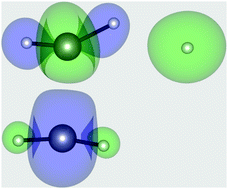Symmetry-breaking effects on time-dependent dynamics: correct differential cross sections and other properties in H+ + C2H4 at ELab = 30 eV
Abstract
We present a computational procedure that introduces low degrees of symmetry breaking into a restricted Hartree–Fock (RHF) state in order to induce higher symmetry breaking during the state's subsequent dynamics. The symmetries herein considered are those of electronic HF states as classified by Fukutome; those symmetries affect bond dissociations and internal rotations among other phenomena. Therefore, this investigation extends a part of Fukutome's time-independent analysis of symmetry breaking to the time-dependent (dynamical) regime. The procedure is formulated in the framework of the simplest-level electron nuclear dynamics, a time-dependent, variational, on-the-fly and non-adiabatic method that employs classical dynamics for the nuclei and a Thouless single-determinantal state for the electrons. We test this procedure on the H+ + C2H4 reaction at 30 eV due to its conspicuous display of symmetry-breaking effects; this reaction is relevant in astrophysics and proton cancer therapy. Fukutome's axial spin density wave (ASDW) HF state is used to represent the symmetry-broken initial states. Through a Thouless parameter, small degrees of symmetry breaking are introduced into the initial ASDW states in a controlled manner. After starting the dynamics from those states, higher degrees of symmetry breaking emerge or not as determined by the direct-dynamics equations without external interventions. Simulations starting from symmetry-conforming states preserve symmetry features during dynamics, whereas simulations starting from symmetry-broken states display an upsurge of symmetry breaking when the reactants collide. Initial symmetry breaking increases the total integral cross sections of collision-induced fragmentations and of target-to-proton 1-electron-transfer reactions and decreases the scattering angle function and primary rainbow angle of the outgoing projectile. Remarkably, symmetry-breaking simulations reproduce the correct relative order and values of the experimental 0- and 1-electron-transfer differential cross sections, whereas symmetry-conforming simulations predict incorrect order and values. Our calculated scattering angle functions and differential cross sections also exhibit expected primary and secondary rainbow angle features that experiments fail to detect. A detailed discussion on the description of symmetry-breaking processes with the ASDW and Thouless states is included to provide a rigorous theoretical basis for this investigation.



 Please wait while we load your content...
Please wait while we load your content...